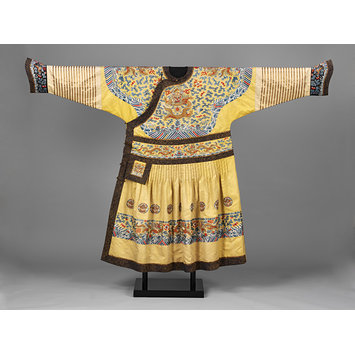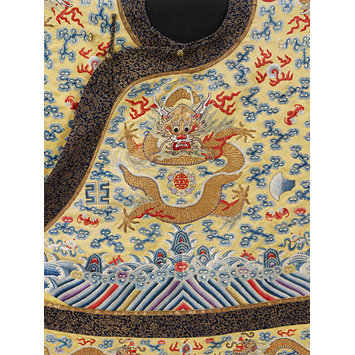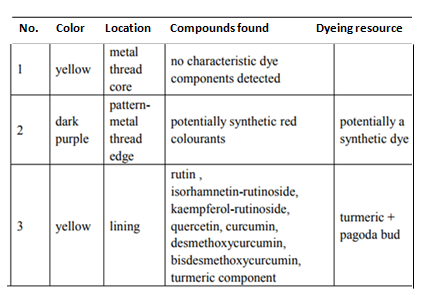V&A T.753-1950, Emperor's court robe, China (1875-1908)
Artifact Information
This is a full length court robe with a fully gathered skirt which is right-side fastening with gilt buttons. It has long and tight sleeves with horse-hoof cuffs. It has a yellow silk plain weave lining throughout [1].
By close examination, it was that that the robe has a yellow twill (2/1) ground embroidered with floss silks and gilt threads in satin stitch and couched work. The robe is identified as one made for the emperor because the robe bears the "twelve symbols", a design that was reserved for exclusive usage for an emperor's court clothes. The "twelve symbols" are: the Sun and Moon discs are on shoulders, the three star Constellation and the Mountain are at neck level, the Axe Head, the Fusymbol (resembling two Es back to back), the Pheasant and the Dragon are on the upper part of the garment, the pair of Sacrificial Cups, the Flames, the Waterweed and the Grains are on the skirt band.
Victoria and Albert Museum, London, UK T.753-1950
Summary of results
Traditionally used Chinese dyes, pagoda tree buds and turmerichad been identified as the dyeing sources of this Chinese court robe [2]. The result is consistent with previous studies. Identification of a synthetic dye is also mentioned. The result agreed with the date of the robe, a late 19th century to early 20th century date. That was when synthetic dyes was imported and been used by dyers in China.
References
[1] https://collections.vam.ac.uk/item/O71648/emperors-court-robe-unknown/
[2] Jing Han, The Historical and chemical investigation of dyes in high status Chinese costume and textiles of the Ming and Qing Dynasties (1368-1911) PhD thesis, University of Glasgow February 2016.


